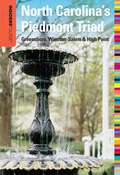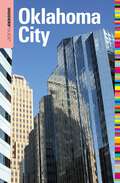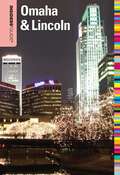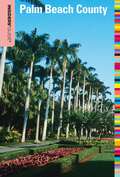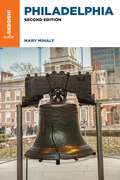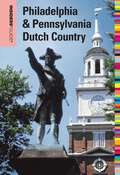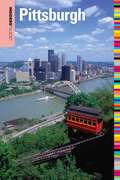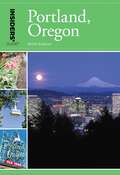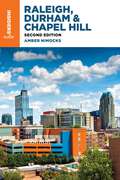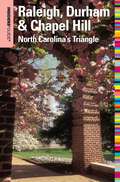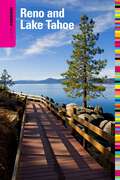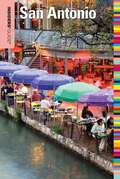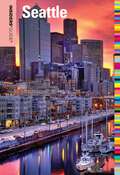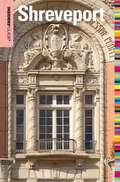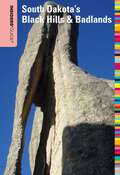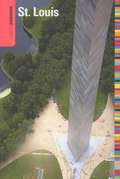- Table View
- List View
Insiders' Guide® to North Carolina's Piedmont Triad: Greensboro, Winston-Salem & High Point (Insiders' Guide Series)
by Amber Nimocks Julie A Hill and Associates LLCA first edition, Insiders' Guide to North Carolina's Piedmont Triad is the essential source for in-depth travel and relocation information to North Carolina's Greensboro, Winston-Salem, and Highpoint region. Written by a local (and true insider), this guide offers a personal and practical perspective of North Carolina's Piedmont Triad and its surrounding environs.
Insiders' Guide® to Oklahoma City (Insiders' Guide Series)
by Deborah BouzidenInsiders' Guide to Oklahoma City is the essential source for in-depth travel and relocation information to Oklahoma's captial city. Written by a local (and true insider), it offers a personal and practical perspective of Oklahoma City and its surrounding environs.
Insiders' Guide® to Omaha & Lincoln (Insiders' Guide Series)
by Sarah Baker HansenA first edition, Insiders' Guide to Omaha & Lincoln is the essential source for in-depth travel and relocation information to Lincoln and the Omaha-Council Bluffs metro areas. Written by a local (and true insider), this guide offers a personal and practical perspective of the Omaha, NE, Lincoln, NE, Council Bluffs, IA, and its surrounding environs.
Insiders' Guide® to Orange County, CA (Insiders' Guide Series)
by Elizabeth BorstingYour Travel Destination. Your Home. Your Home-To-Be.Orange CountyThe quintessential California getaway. The real OC. Sunshine and surf. Suburban sensibilities and urban nuances.• A personal, practical perspective for travelers and residents alike• Comprehensive listings of attractions, restaurants, and accommodations• How to live & thrive in the area—from recreation to relocation• Countless details on shopping, arts & entertainment, and children&’s activities
Insiders' Guide® to Palm Beach County (Insiders' Guide Series)
by Steve WinstonA first edition, Insiders' Guide to Palm Beach County is the essential source for in-depth travel and relocation information to the sandy beaches of Florida. The guide covers Boca Raton, Delray Beach, Boynton Beach, Lake Worth, Wellington, Palm Beach, West Palm Beach, Jupiter, and Palm Beach Gardens. Written by a local (and true insider), this guide offers a personal and practical perspective of the Palm Beach County.
Insiders' Guide® to Palm Springs (Insiders' Guide Series)
by Ken Van VechtenPalm Springs is the essential source for in-depth travel and relocation information to this beautiful Palm Spring, California. Written by a true insider, it offers a personal and practical perspective of Palm Springs and its surrounding environs.
Insiders' Guide® to Philadelphia
by Mary MihalyFrom the Betsy Ross House to the Liberty Bell to Ghost Tours and Elfreth&’s Alley, discover all that Philadelphia has to offer. Written by local expert, Mary Mihaly, Insiders&’ Guide® to Philadelphia is the essential source on the city of brotherly love. Written for locals and travelers alike, this comprehensive guide covers in-depth travel information and tips, relocation advice, and much more. The newly researched, revised, and up-to-date edition features: Comprehensive listings of notable cuisine, memorable tourist attractions, unique experiences, lively nightlife, and quality accommodationsRecommendations for shopping, entertainment, and children&’s activitiesAdvice on how to live and thrive in the area—from recreation to relocationSuggested itineraries for day trips, annual events, and exploring local secretsDiscover your travel destination. Your home. Your home-to-be.
Insiders' Guide® to Philadelphia & Pennsylvania Dutch Country (Insiders' Guide Series)
by Marilyn Odesser-TorpeyInsiders' Guide to Philadelphia & Pennsylvania Dutch Country is the essential source for in-depth travel and relocation information to Pennsylvania's "City of Brotherly Love." Written by a local (and true insider), this guide offers a personal and practical perspective of the area.
Insiders' Guide® to Phoenix & Scottsdale (Insiders' Guide Series)
by Michael FerraresiYour Travel Destination. Your Home. Your Home-To-Be.Phoenix & ScottsdaleExplore the history of the vast metropolitan area known as the Valley of the Sun. Discover where to find the best Southwestern cuisine. Experience a thriving art and cultural scene.• A personal, practical perspective for travelers and residents alike• Comprehensive listings of attractions, restaurants, and accommodations• How to live & thrive in the area—from recreation to relocation• Countless details on shopping, arts & entertainment, and children&’s activities
Insiders' Guide® to Pittsburgh (Insiders' Guide Series)
by Michele MargittaiFrom the top of the USX Tower to the fountain at Point State Park, explore Pittsburgh and all its offerings.
Insiders' Guide® to Portland, Oregon
by Rachel DresbeckInsiders' Guide to Portland, Oregon is a beautiful full-color guide and the essential source for in-depth travel information for visitors and locals to this ever-growing city. Written by a local (and true insider), Insiders' Guide to Portland, Oregon offers a personal and practical perspective of this location that makes it a must-have guide for travelers as well as residents looking to rediscover their hometown.
Insiders' Guide® to Raleigh, Durham & Chapel Hill (Insiders' Guide Series)
by Amber NimocksFrom Eno River State Park to the North Carolina Botanical Garden to Fayetteville and Franklin Street,, Insiders&’ Guide® to Raleigh, Durham, and Chapel Hill is the essential source on North Carolina&’s triangle. Written for locals and travelers alike, this comprehensive guide covers in-depth travel information and tips, relocation advice, and much more. The newly researched, revised, and up-to-date edition features: Comprehensive listings of notable cuisine, memorable tourist attractions, unique experiences, lively nightlife, and quality accommodations Recommendations for shopping, entertainment, and children&’s activities Advice on how to live and thrive in the area—from recreation to relocation Suggested itineraries for day trips, annual events, and exploring local secrets
Insiders' Guide® to Raleigh, Durham & Chapel Hill: North Carolina's Triangle (Insiders' Guide Series)
by Amber NimocksA first edition, Insiders' Guide to Raleigh, Durham & Chapel Hill is the essential source for in-depth travel and relocation information to what is one of the fastest growing regions in the United States. Written by a local (and true insider), this guide offers a personal and practical perspective of the Raleigh, Durham, and Chapel Hill area.
Insiders' Guide® to Reno and Lake Tahoe (Insiders' Guide Series)
by Jeanne WalpoleThis authoritative guide will show you how to navigate the crystal-clear waters of Lake Tahoe and the exciting nightlife of &“The Biggest Little City in the World.&”
Insiders' Guide® to Richmond, VA (Insiders' Guide Series)
by Maureen EganInsiders' Guide to Richmond is the essential source for in-depth travel and relocation information to Virginia's capital city. Written by a local (and true insider), this guide offers a personal and practical perspective of Richmondand its surrounding environs.
Insiders' Guide® to San Antonio (Insiders' Guide Series)
by John Bigley Paris PermenterYour Travel Destination. Your Home. Your Home-To-Be.San AntonioStroll along the River Walk and grab a bite to eat. Relive history at the Alamo. Experience the exotic blend of Texas frontier and Mexican marketplace.• A personal, practical perspective for travelers and residents alike• Comprehensive listings of attractions, restaurants, and accommodations• How to live & thrive in the area—from recreation to relocation• Countless details on shopping, arts & entertainment, and children&’s activities
Insiders' Guide® to San Diego (Insiders' Guide Series)
by Maribeth Mellin Judith Devlin Jane OnstottSan Diego, California&’s second largest city with 70 miles of beaches and a mild Mediterranean climate, is popular for visitors—temporary or permanent. Insiders&’ Guide to San Diego is the quintessential and comprehensive source for travel and relocation information about this sprawling, spectacular Southern California city. Take advantage of the personal perspective of the local authors to gain detailed knowledge necessary to making the most of your experience. Now in its sixth edition, this fully updated and revised guide includes seven maps and 32 black-and-white photographs.
Insiders' Guide® to Santa Barbara (Insiders' Guide Series)
by Leslie WestbrookYour Travel Destination. Your Home. Your Home-To-Be.Santa Barbara Grab a bite at a gourmet restaurant. Explore Channel Islands National Park. Relax, take a sip, and savor Santa Barbara’s wine country. • A personal, practical perspective for travelers and residents alike• Comprehensive listings of attractions, restaurants, and accommodations• How to live & thrive in the area—from recreation to relocation• Countless details on shopping, arts & entertainment, and children’s activities
Insiders' Guide® to Santa Fe (Insiders' Guide Series)
by Nicky LeachInsiders' Guide to Santa Fe is the essential source for in-depth travel and relocation information to this beautiful New Mexico city. Written by a local (and true insider), it offers a personal and practical perspective of Sante Fe and its surrounding environs.
Insiders' Guide® to Savannah & Hilton Head (Insiders' Guide Series)
by Georgia ByrdInsiders' Guide to Savannah and Hilton Head is the essential source for in-depth travel and relocation information to these treasured Southern cities. Written by a local (and true insider), this guide offers a personal and practical perspective that makes it a must-have guide for travelers as well as residents looking to rediscover their home city of Savannah or nearby Hilton Head.
Insiders' Guide® to Seattle (Insiders' Guide Series)
by Shelley SealeA first edition, Insiders' Guide to Seattle is the essential source for in-depth travel and relocation information to this thriving city in the Pacific Northwest. Written by a local (and true insider), this guide offers a personal and practical perspective of Seattle and its surrounding environs.
Insiders' Guide® to Shreveport (Insiders' Guide Series)
by David OttoYour Travel Destination. Your Home. Your Home-To-Be.ShreveportA place of hidden treasures and Southern charm. Casinos, culture, fine dining, and outdoor fun. • A personal, practical perspective for travelers and residents alike• Comprehensive listings of attractions, restaurants, and accommodations• How to live & thrive in the area—from recreation to relocation• Countless details on shopping, arts & entertainment, and children's activities
Insiders' Guide® to South Dakota's Black Hills & Badlands (Insiders' Guide Series)
by T. D. Griffith Nyla GriffithYour Travel Destination. Your Home. Your Home-To-Be.South Dakota&’s Black Hills & Badlands Ghost towns and modern towns. Trendy eateries and rustic bars. Cowboys and artists. Rodeos, skiing, hiking, and biking. Breathtaking landscapes in a place of welcoming smiles. • A personal, practical perspective for travelers and residents alike• Comprehensive listings of attractions, restaurants, and accommodations• How to live & thrive in the area—from recreation to relocation• Countless details on shopping, arts & entertainment, and children&’s activities
Insiders' Guide® to St. Louis (Insiders' Guide Series)
by Dawne MasseyWith this guide, readers will get an inside perspective on St. Louis--the city's more than 170 parks, a thriving live music and local arts scene, an abundance of nightclubs and casinos, and world-class sports teams, not to mention the Gateway Arch.
Insiders' Guide® to Tucson (Insiders' Guide Series)
by Mary Paganelli VottoYour Travel Destination. Your Home. Your Home-To-Be.TucsonSavor the Southwestern cuisine. Bask in 350 days of sunshine a year. Find inspiration in the desert and mountain landscape. • A personal, practical perspective for travelers and residents alike• Comprehensive listings of attractions, restaurants, and accommodations• How to live & thrive in the area—from recreation to relocation• Countless details on shopping, arts & entertainment, and children&’s activities
